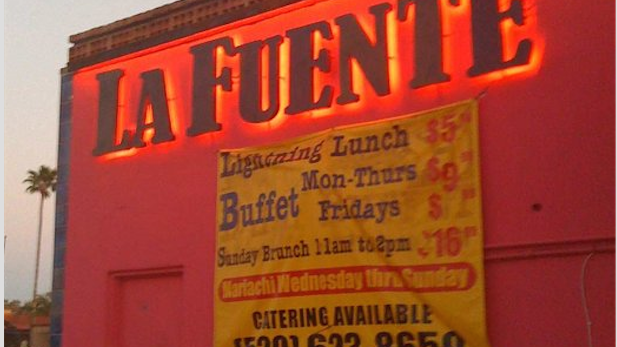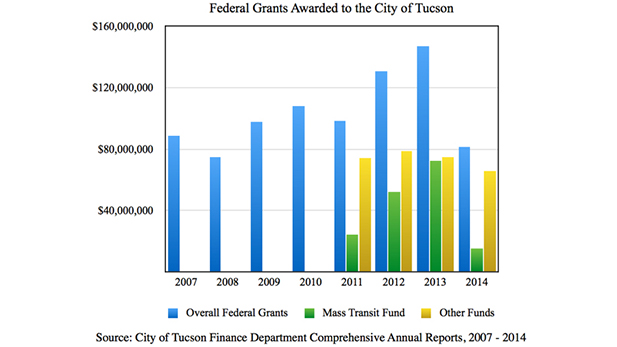
Listen:
By Julianne Stanford, AZPM Journalism Intern
On the corner of North Oracle Road and Lester Street in Tucson stands an empty, dilapidated building that was once the popular Mexican food restaurant La Fuente.
“We fought it and fought it, and in the end, we just couldn’t keep the doors open,” owner Carlos Portillo said.
Like many other businesses in Tucson, La Fuente fell victim to the 2008 recession that still reverberates throughout the Tucson economy today.
Before the restaurant closed in August 2014, had been in that location for 55 years and a well-known fixture in the Tucson community.
A variety of factors contributed to closing the restaurant Portillo said, such as the road and freeway closures during the time when the I-10 was being widened, and the overall deterioration of the neighborhood where the restaurant was located.
“We survived all of those things, even though it was hard,” Portillo said.
But once the recession hit, it all became too much.
One day the restaurant was open, serving its locally famous authentic Mexican cuisine accompanied by mariachi music, and by night the doors were closed indefinitely, without any prior notice to the public.
“We couldn’t keep it open,” Portillo said. “The clientele just wasn’t there, even though we were very popular with the tourists. But I guess we didn’t get enough local support.”
The Portillos were not alone in their struggle to keep their heads above water. Many Tucsonans felt pressure from the downturn, and are still feeling the effects today.
Seven years after the official end of the recession, Tucson is still in the process of recovering. In fact, a recently published study from personal finance website Wallet Hub labeled Tucson as the second least recovered city in America out of 150 major metropolitan cities.
Additionally, Phoenix, Mesa, Tempe and Glendale were also ranked among the fifteen least recovered from the recession.
“In fact, Arizona, Phoenix, and Tucson were hit much harder than the national economy and most other metro areas in the nation,” Economist George Hammond said. He is the Director of the Economic and Business Research Center at the University of Arizona’s Eller College of Management.
The study compared the pre-and-post recession rates of 17 economic factors, including unemployment rates, poverty rates, foreclosure rates and changes median household incomes.
In many of these areas, Tucson has been lagging behind the state and national level of recovery.
“In 2014, Tucson had recovered 33 percent of the jobs lost during the Great Recession. Phoenix had recovered 62 percent,” CEO and President of the Tucson Metro Chamber Mike Varney said. “Arizona had recovered 55 percent and the US as a whole had recovered 92 percent. So that’s a very telling statistic about our local community.”
Although the median household income level has decreased across the nation since 2007, Tucson saw a steeper decline in income that has had a comparatively slow rebound. Prior to the recession, the median household income in the city was $62,038, compared to $65,867 in Arizona and $68,727 in the nation.
In 2013, the median household income in Tucson was $43,824, whereas statewide it was $48,510 and $52,250 nationally.
The local housing market took a massive hit at the onset of the recession, causing the economy to tank even further, President of the Tucson Realtors Association Nicole Brule-Fisher said.
“Prior to 2008, in 2005, 2006, we we’re really at the height of the market here, where things were substantially going up at record paces,” Brule-Fisher said.
Then the crash came.
The median home selling price dropped by almost fifty percent in 2008 and there was an average of 1,000 foreclosures a month during the recession, Brule-Fisher said.
However, UA economist Hammond says things may not actually be as bleak as the numbers make it seem.
“Tucson is growing. We are adding jobs, we’re adding residents, our income is rising,” Hammond said. “The growth is slow compared to the nation, compared to any other metro areas and even compared to our own past history.”

Hammond said one of the primary factors in Tucson’s slow recovery has been city’s reliance on federal funding.
“Tucson is much more dependent on overall federal funding government spending and federal government activity than are more metropolitan areas around the country,” he said. “In fact, federal government activity accounts for twice of our gross domestic product as it does for the state or the nation.”
After the recession, it appeared that Tucson began to receive more grant money from the federal government, but those numbers are misleading.
The surge was largely due to a grant that was allocated for developing the city’s mass transit system through the Sunlink streetcar. Comparatively, the actual amount of money the city has received from the federal government for everything else has seen a 25 percent drop since 2007.
That drop in funding has created what Hammond calls “federal fiscal drag,” which occurs when the national government reduces spending in a local area that causes a shock to its economy.
Although Hammond finds the federal government as a factor in the city’s problematic recovery, Chamber President Varney said it might be the solution,
“We’re going to have to have a change in policy in DC that takes the federal government’s foot off of the brake pedal regarding the development of our economy,” he said. “We tend to want to overregulate businesses to the point where it is too expensive for them to do the things they could do. We tax them at a very high level. That’s not an incentive to grow the economy.”
Despite the foreseeable long road to recovery, Hammond says there is some immediate relief for individual households.
“I think we’ll see as house prices continue to rise, fewer households will be under water on their mortgages and that will help to increase residential mobility,” he said.
Additionally, the dramatic drop in gasoline prices over the past year has brought some major help. One year ago, the average price for a gallon was $3.15. Today, you can get a gallon for less two dollars at some stations throughout the city.
“That frees up a significant amount of funds for an average household’s budget and they can use that to save, to pay down debt, or they can use it to a little bit of additional spending on cars or house,” Hammond said.
With increased cash in their pockets for the first time in years, people can start spending on luxury items, such as eating out at restaurants like the Sierra Vista location of La Fuente. The Portillos opened it up two months before the unexpected closure of the Tucson location.
But for those of you who miss La Fuente’s presence in Tucson, there is still the possibility for it to open once again in the future, Portillo said.
“I went to Tucson yesterday, and I haven’t been there in probably about three or four months, and I was thinking on the way down there the building is still empty and if would get some investors, that’d be great to reopen the restaurant,” Portillo said. “I think people would love to see that in Tucson because it was like a landmark.”
The bottom line: While the Tucson economy still has some work to do to fully recover from the recession, it will take a bit more time.

By submitting your comments, you hereby give AZPM the right to post your comments and potentially use them in any other form of media operated by this institution.